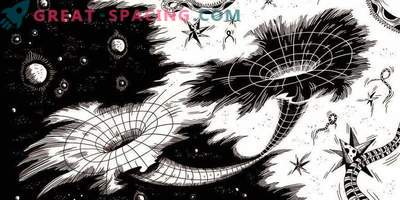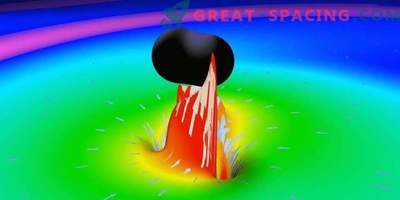
Visualization of a supercomputer model demonstrates how positrons behave near the event horizon of a rotating black hole.
The gravitational attraction of a black hole is so great that even the light cannot escape, if it approaches a critically close distance. But you have a chance to escape. True, you need to be a subatomic particle.
As black holes absorb matter in the environment, they also eject powerful jets of hot plasma with electrons and positrons. Before the particles reach the event horizon (point of no return), they begin to accelerate. When moving at a speed close to the speed of light, these particles ricocheted out of the event horizon and pushed out along the axis of rotation of the black hole.
The phenomenon is called relativistic jets. These are gigantic and strong streams of particles emitting light. Scientists have watched such jets for dozens of years, but no one understands exactly how runaway particles receive the necessary energy.
To find the answer, the researchers developed a new set of simulations for a supercomputer that combined ten-year-old theories to provide new insights into the plasma jet mechanisms that allow stealing energy from the powerful gravitational fields of black holes.
Simulation for the first time unites theory, which explains how electric currents around a black hole wring magnetic fields in a jet, with theory, where it is revealed how particles crossing the event horizon can reduce the total energy of rotation of a black hole. The model had to take into account not only the acceleration of particles and the light emanating from relativistic jets, but also the way positrons and electrons are created (a collision of high-energy photons, like gamma rays). This is a pair formation that can transform light into matter. The results of the new modeling do not radically deviate from the previous findings, but provide some interesting nuances. For example, it was possible to find a large aggregate of particles whose relativistic energies are negative, as measured by observers far from a black hole. When they fall into a black hole, its total energy is reduced.
In addition, scientists are faced with a surprise. It turned out that so many particles with negative energy enter the black hole that the energy extracted by the fall is comparable to that of the surrounding magnetic field. If the observations confirm this, then the influence of particles with negative energy is so strong that it can change the expectations regarding the emission spectra of black hole jets.
The team plans to improve the models by comparing the data with real observations of observatories, like the Event Horizon telescope (its goal is to take the first photos of a black hole).











































